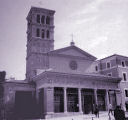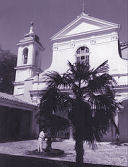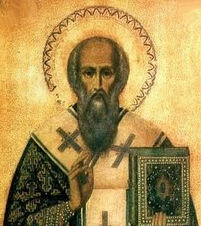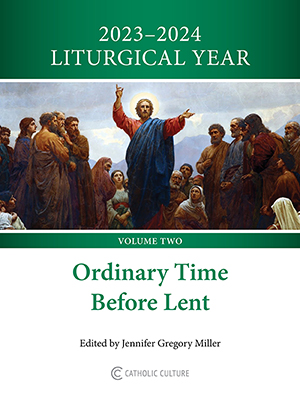Lent: February 26th
Thursday After Ash Wednesday
Other Commemorations: Saint Porphyrius, Bishop (RM)
» Enjoy our Liturgical Seasons series of e-books!
Yesterday we began Lent. Today we take up our cross and follow Christ. We are presented with a choice, "Today I have set before you life and prosperity, death and doom. . . Choose life, then, that you and your descendants may live, by loving the Lord, your God, heeding his voice, and holding fast to him."
In her effort to inspire us with courage for the coming battle, the Church puts heroes before our eyes at the very outset of Lent. The first hero is the soldier George, the station saint. He proved himself mightier than the dragon, a thrilling accomplishment. Christ also is challenging the powers of darkness; He must fight the dragon from hell and crush his head. The same holds for the mystical Christ, the Church. Catechumens, penitents, faithful — all must do battle with the dragon. ...Today the fighting proceeds under the flag and leadership of the solider St. George. It is a battle of life or death. Only he who declares total war on the dragon can hope for life in abundance. — The Church's Year of Grace
Prayer Is the Breath of the Soul
“Prayer is the breath of the soul ”: this definition of prayer highlights the vital importance of prayer in our lives. In fact who could ever say to one's breath: “today I have no time for you?”. If we had no time to breathe, any other action would be impossible simply because we lack the strength. Without breath, human life cannot exist. The same is true of prayer: everything depends on it, in the sense that with prayer God's grace enables us to face the trials of life, to overcome temptation and to complete the tasks assigned to us by Divine Providence. But without prayer we can do nothing which is truly good and of eternal value, for ourselves or for others. A crisis of faith is essentially a crisis of prayer. We will never learn to confide in God unless we become familiar with Him, with the afflatus of the soul which is nurtured only by prayer. To receive the Holy Spirit, who, as Jesus says, is similar to “the wind” (cfr. Jn 3, 8), we must pray in order to open our will, our intellect and our memory to the Love of God. The Church Fathers and Doctors, the great masters of the spiritual life, all tell us that prayer is the heart of the Christian life: if the heart stops beating, life is extinguished!
So, in the light of the revealed Truth, we can truly say that there can be no spiritual life, nourished day after day, without a journey of prayer which the great mystical doctor St John of the Cross for example calls the “ascent of Mount Carmel”. In fact a journey of prayer is an “ascent”, because those who undertake it experience the fatigue of prayer, with its periods of aridity and darkness, against which it is necessary “struggle”. But if we obey Jesus' teaching on prayer - “Stay awake, praying at all times for the strength to survive all that is going to happen, and to hold your ground before the Son of man.' ” (Lk 21, 36) - we experience ever deeper personal communion with the Lord and with the Church, and eventually, prayer becomes the “breath” of the soul, as it is meant to be.
God makes use of everything: life's temptations, sins, trials, joys and sadness, in order to “convince us” and “win us” for prayer, so that it becomes in us “continual”, like a flowing stream bringing fresh, life-giving water to our whole being. People who pray with the heart, make prayer the “centre” of life, and live a relation with Jesus which is effective not theoretic: they live of Him, with Him and for Him. In a praying heart the Lord's promise is perfectly fulfilled: “'So I say to you: Ask, and it will be given to you; search, and you will find; knock, and the door will be opened to you. For everyone who asks receives; everyone who searches finds; everyone who knocks will have the door opened. What father among you, if his son asked for a fish, would hand him a snake? Or if he asked for an egg, hand him a scorpion? If you then, evil as you are, know how to give your children what is good, how much more will the heavenly Father give the Holy Spirit to those who ask him!” (Lk 11, 9-13). . . . .
Who better than the Blessed Virgin Mary can introduce us and guide us to the mystery of prayer! Who other than Mary knows the perfect path of prayer which leads to the Heart of her Son and through Him, to the Heart of the Father! May Mary in her maternal concern, remove from our soul anything which prevents us from living an authentic life of prayer and may She illuminate our mind with regard to the unrivaled majesty and beauty of the Face of Jesus, which shines on those who adore Him!
Excerpted from Rev. Luciano Alimandi, Ave Maria
 Today's station is at St. George's. Pope St. Gregory established a diaconia, an institution that cared for the poor, at the site of this church. The area has a special place in the history of Rome, as an ancient tradition claims that it was here that Romulus killed his brother Remus before founding the city.
Today's station is at St. George's. Pope St. Gregory established a diaconia, an institution that cared for the poor, at the site of this church. The area has a special place in the history of Rome, as an ancient tradition claims that it was here that Romulus killed his brother Remus before founding the city.Saint Porphyrius
Saint Porphyrius, Archbishop of Gaza, was born about the year 346 at Thessalonica. His parents were people of substance, and this allowed St Porphyrius to receive a fine education. Having the inclination for monastic life, he left his native region at twenty-five years of age and set off for Egypt, where he lived in the Nitrian desert under the guidance of St Macarius the Great (January 19). There he also met St Jerome (June 15), who was then visiting the Egyptian monasteries. He went to Jerusalem on pilgrimage to the holy places, and to venerate the Life-Creating Cross of the Lord (September 14), then he moved into a cave in the Jordanian wilderness for prayer and ascetic deeds.
After five years, St Porphyrius was afflicted with a serious malady of the legs. He decided to go to the holy places of Jerusalem to pray for healing. As he lay half-conscious at the foot of Golgotha, St Porphyrius fell into a sort of trance. He beheld Jesus Christ descending from the Cross and saying to him, "Take this Wood and preserve it."
Coming out of his trance, he found himself healthy and free from pain. Then he gave away all his money to the poor and for the adornment of the churches of God. For a time he supported himself by working as a shoemaker. The words of the Savior were fulfilled when the saint was forty-five years old. The Patriarch of Jerusalem ordained St Porphyrius to the holy priesthood and appointed him custodian of the Venerable Wood of the Cross of the Lord.
In 395 the bishop of the city of Gaza (in Palestine) died. The local Christians went to Caesarea to ask Metropolitan John to send them a new bishop who would be able to contend against the pagans, which were predominant in their city and were harassing the Christians there. The Lord inspired the Metropolitan to summon the priest Porphyrius. With fear and trembling the ascetic accepted the office of bishop, and with tears he prostrated himself before the Life-Creating Wood and went to fulfill his new obedience.
In Gaza there were only three Christian churches, but there were a great many pagan temples and idols. During this time there had been a long spell without rain, causing a severe drought. The pagan priests brought offerings to their idols, but the woes did not cease. St Porphyrius imposed a fast for all the Christians; he then served an all-night Vigil, followed by a church procession around the city. Immediately the sky covered over with storm clouds, thunder boomed, and abundant rains poured down. Seeing this miracle, many pagans cried out, "Christ is indeed the only true God!" As a result of this, 127 men, thirty-five women and fourteen children were united to the Church through Holy Baptism, and another 110 men soon after this.
The pagans continued to harass the Christians. They passed them over for public office, and burdened them with taxes. St Porphyrius and Metropolitan John of Caesarea journeyed to Constantinople to seek redress from the emperor. St John Chrysostom (September 14, January 27 and 30) received them and assisted them.
Ss. John and Porphyrius were presented to the empress Eudoxia who was expecting a child at that time. "Intercede for us," said the bishops to the empress, "and the Lord will send you a son, who shall reign during your lifetime". Eudoxia very much wanted a son, since she had given birth only to daughters. Through the prayer of the saints an heir was born to the imperial family. As a result of this, the emperor issued an edict in 401 ordering the destruction of pagan temples in Gaza and the restoration of privileges to Christians. Moreover, the emperor gave the saints money for the construction of a new church, which was to be built in Gaza on the site of the chief pagan temple.
St Porphyrius upheld Christianity in Gaza to the very end of his life, and guarded his flock from the vexatious pagans. Through the prayers of the saint numerous miracles and healings occurred. The holy archpastor guided his flock for twenty-five years, and reposed in 420 at an advanced age.
—Excerpted from A...Sinner blog
Highlights and Things to Do:
- Learn more about St. Porphyrius:
- Read Deacon Mark's biography, The life of Porphyry, bishop of Gaza.
 Monday of the Second Week of Lent
Monday of the Second Week of Lent
Station with San Clemente (St. Clement):
The oldest level of St. Clement's is thought to be the titulus Clementis, one of the first parish churches in Rome, and probably belonged to the family of Titus Flavius Clemens, consul and martyr and a contemporary of Pope St. Clement. Set right next to a pagan temple, a Mithraeum or Temple of Mithras, it was one of the first churches in Rome.
For more on San Clemente, see:
For further information on the Station Churches, see The Stational Church.








